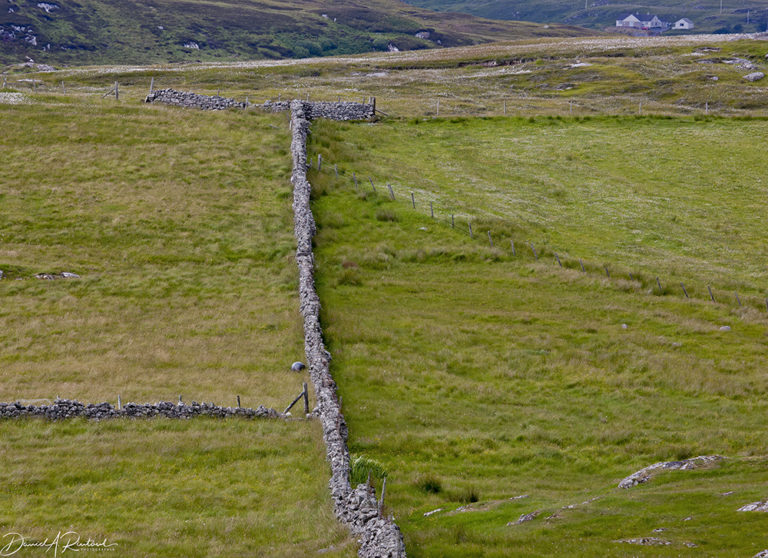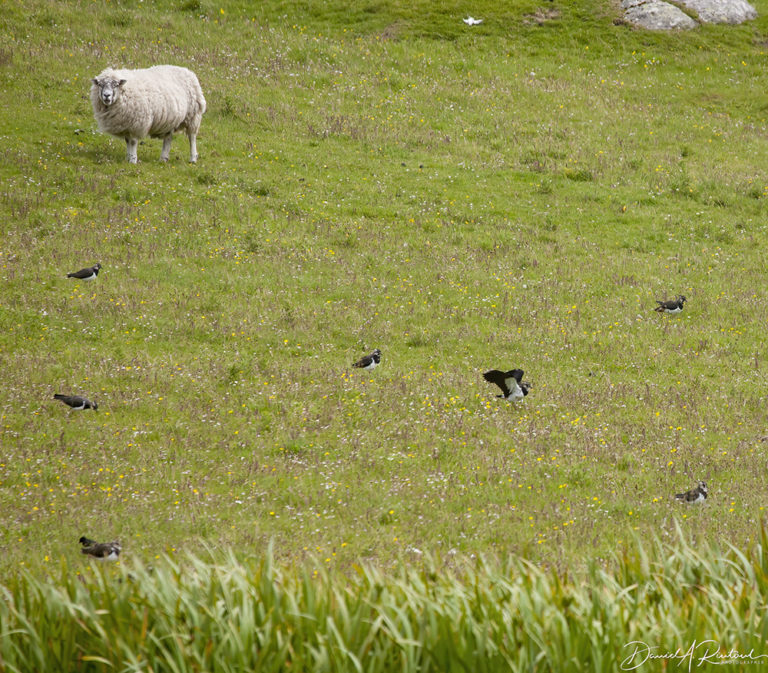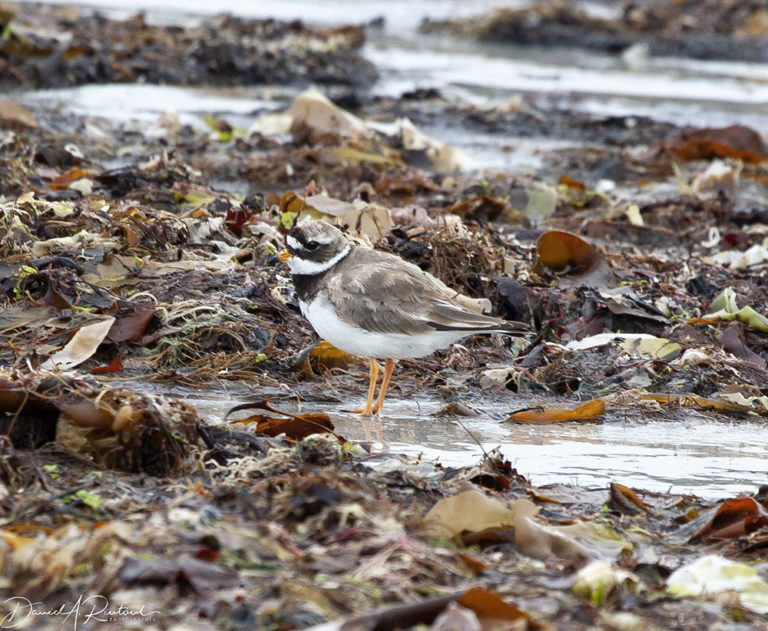On the Road is a weekday feature spotlighting reader photo submissions.
From the exotic to the familiar, whether you’re traveling or in your own backyard, we would love to see the world through your eyes.
Albatrossity in Scotland
We spent a couple of days poking around on Uist, both at the Balranald reserve and wider afield. Per usual, we had some sunny intervals, but generally the weather was either overcast or actively raining. The locals seem to ignore that kind of weather, so we adjusted accordingly. We did see the bird that Balranald is most noted for, the rare and endangered Corncrake, but it was a brief sighting as the bird scooted across the trail in a brief downpour. So no pics of that one!

One of the sites that Elizabeth wanted to see was a 5000 year-old tomb known as Barpa Langass. One of the amazing things about stone structures in this part of the world is both how ancient they are, and how much access you have to clamber around them and even crawl around inside. My 6’4″ frame was not going to be happy inside this one, but Elizabeth was eager to explore it. So here is a picture of the tomb and entrance, and a picture of how to exit from an ancient chambered tomb, using Elizabeth as a model.

Emergence from the chambered tomb.

From Barpa Langass it is a short hike to another archaeological site, the stone circle known as Pobull Fhinn. It is on a bit of level ground (probably partly leveled by the builders) on the north side of Loch Langais, and is thought to date from the second millennium BC. There are about 50 stones in an elliptical arrangement, but only a few are still standing. On a sunny day the views would be amazing; we did not have that day, so this is what we got. Given its location, relatively close to a main road and a nice hotel (The Langass Lodge, which has an excellent restaurant), this might be one of the most photographed places on Uist.

Standing stones of Pobull Fhinn, with Loch Langais and a distant peak in the lowering gloom (Lì a Deas, or South Lee, elevation 281 m).

The pastures on the Outer Hebrides are often demarcated with drystone fences, which reminded me of the stone fences I am familiar with in the Flint Hills of Kansas. When you have a lot of rocks and hardly any trees, your fencing solutions might involve heavy lifting…

I got another life bird here, the Northern Lapwing (Vanellus vanellus). Here is a distant shot of a small flock of those, landing in front of a skeptical sheep.

The shores here are quite attractive for migrant birds, although we were a bit early for the peak of the shorebird migration. But some were starting to trickle through. This is a common plover in Britain and far northern Europe, the Ringed Plover (Charadrius hiaticula) on a wrack-strewn shore. Amazingly, there were some folks swimming just off this beach, without wet suits or other gear. That is mostly amazing because this place is at approximately the same latitude as Juneau, Alaska. The Gulf Stream warms these waters a bit, but not very much!

The most common migrant shorebird here is probably the Dunlin (Calidris alpina), a dumpy peep with a black belly and a droopy bill. These are circumpolar, and I have even seen them in Kansas, but it was nice to find some poking about in the washed up flotsam on this beach.

Mary G
So many interesting places you take us to, Albatrossity! How many birds do you have on your life list?
Princess Leia
The best thing about Mondays are your photos!!
Albatrossity
@Mary G and Princess Leia: Thanks! These days when it is tough to get to interesting places, I have found that going back through the images from these older trips is good for my soul as well.
Re birds on my life list, I really don’t know. I long ago gave up counting and started focusing on getting good images of fewer birds rather than long lists of more birds. And given the taxonomic rearrangements that are constantly taking place in the age of DNA sequencing, it would be a frustrating task to keep track of species gained and species lost from your life list every time a new taxonomy is run up the flagpole. Who needs more frustration these days? Not me.
Mike S (Now with a Democratic Congressperson!)
@Albatrossity: Nice! Enjoyed these very much! The Scottish Isle are a place I’d like to visit. One of my Great…… Grandfathers left the Isle of Mull (A bit farther south ) in 1712 and his branch of the family was on the losing side of a war with the English.
BTW: if you put your bird sightings in eBird, it keeps track of all the changes (splits and lumpings of species) for you.
Albatrossity
@Mike S (Now with a Democratic Congressperson!): Thanks. I do put some of my sightings on eBird these days, and it tracks those lumps and splits admirably. My problem is that I have been birding for 50+ years, long before eBird was a twinkle in the eye of the Cornell folks, and I have no desire to go through the process of adding those older sightings. Yeah, I know I should, but somehow I have found other things to do that are more personally rewarding!
blacque_jacques
You can’t fool me. There’s no such thing as summer in Scotland.
Seriously, check out “The Modern Antiquarian” on YouTube. It’s an engaging documentary of English and Scottish ancient mounds, stone circles and tombs, researched by Julian Cope, formerly of The Teardrop Explodes.
Sorry I don’t have a link. I’m on an old computer that haz a sad when Balloon Juice and YouTube try to run together.
Lapassionara
These are wonderful! Thanks for taking us along on your trips.
Mike S (Now with a Democratic Congressperson!)
@Albatrossity: That’s about how long I’ve been birding too. What I did was after about 6 or 7 years of ebirding I just went through my old life list Checklist of the ABA region and put in lists/sightings for the relatively small number of species that were missing. So my first seen dates aren’t correct for many North American birds, but all the species are there. If you don’t know an exact date, you can put records in as January 1, 1900 and eBird ignores those records, but they will be on your life list. I’m lucky that all my foreign travel have been during the eBird epoch.
Albatrossity
@Mike S (Now with a Democratic Congressperson!): That’s good for folks who have good records (i.e., not me). And if I cared about a life list more than I do, I probably would have done that already.
Another interesting solution that a friend of mine used was to start his life list over when he retired. That gave him an excuse to go to all the cool North American birding hotspots (e.g. Lower Rio Grande Valley, SE Arizona, Salton Sea, prairie pothole region, Cape May, Sanibel, etc) at least one more time. I also considered doing that, but decided that I really would rather concentrate on images rather than lists. Not good for the eBird database, but it works for me!
Isua
These are lovely! I’m dying to go there because a) I’m obsessed with bleak northern hinterlands and b) I’m obsessed with old tombs and ruins. I need to check out the Modern Antiquarian you guys linked above, that sounds like exactly my jam.
I’m generally a lurker, so I should take this opportunity to say that all of you are amazing, and thank you so much for everything you all contribute to this site. Even if I’m just reading and not writing, I’m learning a ton from everyone on Balloon Juice every day.
Kattails
So glad I finally took a a few moments to catch up on our On the Road images, been busy lately–these are just gorgeous. Will go back and check the other post. I have a particular fondness for moody weather and miss living near the sea (sigh). Lived in south NJ for a few years, on the flyway, amazing during migration season. Scotland has also always been a destination for me, possibly Wales, Cornwall, the Hebrides…
JanieM
These are beautiful, sun or not.
I went inside a stone burial chamber once in England — not that tiny, no crawling, can’t remember the name of it, but the weight of old stone above my head was…unsettling.
The stone wall makes me think it would be fun to do a collection of stone wall pics from Maine (where I live, and where there are a lot of them) and Ireland (where I’ve spent a lot of time but not recently, and would love an excuse to go back). Pandemic be gone!
Victor Matheson
@blacque_jacques: I actually have a Julian Cope album. Peggy Suicides with the single Beautiful Love. Great late 80s/early 90s alternative just before the grunge revolution hit.
Xavier
@Albatrossity: Interesting that SE AZ is a birding hot spot. It is also a place where Vladimir Nabokov went to study butterflies. He wrote parts of Lolita while in Portal, AZ.
Origuy
Were you able to see a sea eagle? I was on a bus going from one end of Mull to the other and the bus driver stopped and said “There’s a sea eagle!” I could never spot it. I believe the official name is white-tailed eagle.
The other time I was in Scotland I went to Clava Cairns, near Inverness. It’s a Bronze Age burial site; there are several mounds and standing stones. We stayed in a cottage on the River Spey. There were two stones down the road; one had a carving on it. It wasn’t very impressive compared to a lot of others, but it was right there.
Albatrossity
@Origuy: Yes, we saw one eagle, but it was soaring at a great distance, and I got no pics. Just the memory.
We also stayed near the Clava Cairns you mentioned, in Kingussie. That part of the trip will be featured in a Monday post down the road a bit.
StringOnAStick
Thanks to Blaque Jacque for The Modern Antiquarian suggestion; we seem to watch a lot of obscure stuff about that area and just finished a multitude of series about narrowboating.
Top of our list for the post pandemic world is Scotland. Thanks for the photos!
StringOnAStick
@Albatrossity: Sometimes the memory is enough, like the 6’+ manta ray we saw at sea, or yesterday’s hike that had us above valley clouds that raced up the ridge and over us for brief moments. One such moment had a flock of birds whirling in the dancing clouds; it was magical, and also something the camera can’t capture so The mind must suffice. The golden aspens were at their peak, and yet with the valley clouds mostly below us, we had perfect views of Mt. Evans and Rosalie. Just a perfect day with weather conditions that are pretty rare here.
Steve from Mendocino
@Albatrossity: My OTR posts are largely older photos, and I do it for exactly the same reasons. In 1975 I had everything stolen from my car in the parking area outside the Seville cathedral, including 10 rolls of 36 exposed Kodachrome. Essentially all my pictures of France, Portugal, and Spain gone, and I’d made a special effort that year to focus on my photography because I felt I’d been slacking. At this point I have no memory of what I did during the month I spent there, whereas that is not true of other years because my photos have kept my memories fresh. C’est comme, ca la vie.
Albatrossity
@Steve from Mendocino: Ouch! Losing those slides would have been a real bite!
My postdoctoral advisor had a similar experience. He and his wife visited China and were there for at least 2-3 weeks. All of his exposed films, and his camera, were in one small suitcase that was stolen in the airport as they were leaving the country. They had nothing except memories for that trip..
J R in WV
@Isua:
I love old ruins and tombs too. The South West has a ton of old ruins built by pre-Columbian residents. All of Europe has them too.
We got to stroll into a large Etruscan tomb on the highest point in the ancient walled city nearest to our rural vineyard turned hotel in Tuscany.
Jealous of your wife, I bet she didn’t take a camera in there, did she? Thanks for this photo set, those islands look pretty bleak to me, but you found so many places and birds to shoot. Great work as usual~!~
Albatrossity
@J R in WV: Thanks! No, as you imagined, Elizabeth did not have a camera with her inside that old tomb. Would have needed a powerful flash, methinks!
Yes, I’d agree that these islands are bleak, especially on rainy days. We did have some stunning blue sky days as well, however. What blew me away was the fact that some of these sites were aligned to the solstice sunrise, sunset or to the lunar standstill moonrise, which happens every 18.6 years. The odds that you would have a clear sky on that one day every year, or one day every 18.6 years, seem slim to me. It makes me even more amazed at the astronomical skills of those ancient folks.